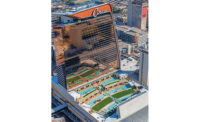Soon to be the largest resort in Arizona, VAI is less than a year from completion on 60 acres in Glendale, led by a vertically integrated general contractor/owner with two generations of heavy-civil building experience. Billed as the state’s first multi-experiential vacation destination, the $1-billion hotel complex centers on a $50-million, 360-degree concert stage, where entertainers will perform for guests in tiered seating, VIP skyboxes or even hotel room balconies.
The resort—promoted as a “fun, awesome experience”—will include four towers of six or eight floors; 1,100-plus luxury rooms, suites and villas up to 5,000 sq ft; five acres of temperature-controlled water; and nearly a mile of palm tree-lined beaches with a proprietary white sand never exceeding 90 degrees Fahrenheit; multiple pools, including two on the rooftop; 12 restaurants; 10 bars and lounges; 80,000 sq ft of approximately 40 retail destinations; and a tethered helium balloon. Additionally, the resort will boast the first indoor Mattel Adventure Park™, where two rollercoasters will move in and out of the building, along with a Hot Wheels go-karting ride, a Barbie Beach House and other attractions.

The $1-billion effort centers on the $50-million, 360-degree stage.
Image courtesy VAI Global Development
Another Las Vegas-level attraction is the 52,000-sq-ft Konos Island, said to be the largest man-made party island in the U.S. It was inspired by beach destinations such as Ibiza, Mykonos and Tulum, and it is anchored by a 16-person aerial bar built 130 ft above the former alfalfa fields.
Fisher Industries, based in Dickinson, N.D., with offices in Tempe, Ariz., is building the mega hotel/resort/entertainment venue with Orlando-based Baker & Barrios, the architect-of-record.
“Our mission is to redefine the luxury hospitality experience while incorporating the thrill of live entertainment,” says Grant Fisher, who is overseeing the project as president of VAI Global Development.

The resort’s design philosophy prioritizes creating captivating experiences.
Image courtesy VAI Global Development
Tunnels and a Marquee Stage
The construction crew has connected the entire campus with 2,000-ft of concrete tunnels, which allow the daily staff and facilities management personnel to fulfil responsibilities to the guests without interfering with their experience and to provide the entertainers unencumbered access to the hotel and the amphitheater/concert stage.
Based on their locations beneath the buildings and other campus amenities, the 9-ft-high tunnels were built in two ways, says Tommy Fisher, Grant’s father and president of Fisher Industries/Construction. With the first method, the crew craned in precast concrete boxes that they then forklifted into place; in other areas, they cast in place the remaining tunnels.
“VAI Resort blends guest experience with architectural placemaking.”
—Ryan McGinn, Executive Project Manager, VAI Global Development
This underground system connects to 30,000 sq ft of entertainment prep areas, including a 2,000-capacity VIP lounge for ticket holders of the first 12 rows and a private elevator that will lift performers to the 360-degree steel-frame amphitheater, explains Howard Weiss, VAI Resort’s senior vice president of entertainment and sponsorships, who is guiding the construction of the 11,000-capacity venue.
Among his tasks are coordinating the sophisticated state-of-the-industry electrical, acoustical and audio components. “Everything our electrical and acoustic teams have done here is highly integrated,” he explains. “We are feeding concerts into the hotel rooms which can be your seat for the shows as well as your overnight accommodations. So our guests can be inside their rooms having food and drinks while enjoying the concerts.”

Roller coasters will take guests outside and then back into the building.
Image courtesy VAI Global Development
A Changing Vision
To ensure VAI would be a transformative project, the company immediately changed the vision after acquiring it two years ago from the original developer; that firm was planning a more traditional water-themed entertainment park that would focus on young people and families.
“You have multiple places throughout the country that offer a water-park destination, but I felt that there wasn’t a five-star destination property that could entertain families but that was geared a little bit more to the 21-and-over crowd,” says Tommy Fisher. His father, Gene, began the Fisher Sand & Gravel Co. in rural North Dakota in 1952, specializing in portable crushing operations. Both Tommy and Grant are Phoenix-area residents.
“VAI will incorporate a child’s kind of happiness and an adult’s, so that parents and grandparents can also ride the roller coasters with their children,” says Fisher. “Even in the heat of the summer, everyone can wait for the ride in the air-conditioning inside.”
“The synergies and efficiencies done on site will continue long after the construction workers are gone."
—Grant Fisher, President, VAI Global Development
“Our design philosophy prioritizes the creation of captivating experiences for our guests,” says Ryan McGinn, executive project manager for VAI Global Development. “VAI Resort blends guest experience with architectural placemaking. We aim to transport guests into a tropical oasis where they can seamlessly transition between relaxation, family-friendly fun and adrenaline-fueled adventures on our new rides and attractions.”
The company says that operating as the owner and contractor has made the process fluid.
“Those two roles are often extremely differentiated—the money aspects and the design and structural ones—and that can often lead to misconceptions and problems,” Grant Fisher explains. “We’re not just an owner coming in with the dollars; we’re coming in with background and experience.”
“When the workers see that the owner is in the trenches with them, it shows that we’re all in this together, and that builds momentum,” adds Tommy Fisher.
In addition, the company is remaining as owner/manager after completing the project in early 2025. “The synergies and efficiencies done on site will continue long after the construction workers are gone. It’s the long haul for us,” Grant Fisher says.
“We’re not in this to develop it for as cheap as we can or as fast as we can to sell it at the end of the day. This is truly a Fisher family legacy project that launches our hospitality brand,” he adds.

Another feature of the resort is the 52,000-sq-ft Konos Island. Touted as the largest man-made party island in the U.S., it is anchored by a 16-person aerial bar.
Image courtesy VAI Global Development
Benefiting From Vertical Integration
The company’s longtime civil engineering experience has reduced design and construction challenges at VAI, Tommy Fisher explains.
Three exits from the Loop 101 serve VAI, the State Farm Stadium, home of the Arizona Cardinals, and the growing Westgate shopping, restaurant, entertainment and hotel campus, so traffic control required a number of entrances and exits to accommodate overnight and event guests as well. There are also conveniently located parking garages, lots and a pedestrian bridge spanning 95th Avenue.
“So many people have had experiences going to a stadium or arena for the concert of their dreams and they’re stuck in traffic and have high anxiety,” says Tommy Fisher. “So what we’ve done is to supply multiple places to enter and exit effortlessly.”
“We’ve brought two lifetimes of experience to this project.”
—Tommy Fisher, President, Fisher Industries/Construction
Coordinating construction of the 11,000-capacity venue is Howard Weiss, VAI Resort’s senior vice president of entertainment and sponsorships including its sophisticated electrical, acoustical and audio components. From the entrance at 95th Avenue, a 100-ft walk will bring ticket holders to their seats; for entertainers, a 30,000-sq-ft below-stage area will include prep rooms and a private elevator to the stage.
“Our carpenters that would normally be building bridges are building our towers,” Tommy Fisher explains. “Many have helped us grow the company and build some of the largest federal projects we’ve worked on, and that is why we brought them here.”
Labor shortages, which remain the nation’s top construction industry issue, have not been challenging. “We are in the decade’s most challenging labor market right now, but with Fisher Industries as the general contractor and with our key subcontractor partners, we have been able to avoid this issue,” McGinn says. At peak, about 1,200 workers will be on site.
He adds that procurement has been improving coming out of the COVID-19 peak; the longest lead time now is electrical equipment. “We are relying on our strong partnerships to navigate any challenges that may arise,” McGinn explains.
Finding trucks and scheduling deliveries have also challenged many projects. But Fisher owns 160 trucks that regularly provide asphalt products from Phoenix. The company also owns a manufacturing facility with conveyors, crushers and other machinery. Additionally, the structural steel for the resort is being produced by a proprietary facility in Coolidge, about 40 minutes south of VAI.

The project team will place about 250,000 cu yd of concrete, rated from 4,000 psi to more than 6,000 psi.
Image courtesy VAI Global Development
Because of the company’s vertical structure, it has avoided some of the usual construction hurdles caused by the COVID-19 pandemic. Arizona has become a leading center for chip manufacturing in the country, with mega-projects such those from Intel and Taiwan Semiconductor, which stress many of the area’s resources, and in particular, concrete. But pours have been generally on schedule, Grant Fisher notes, adding that, to ensure availability, the team placed one of its batch plants on site to output some of the environmentally friendly concrete that has been used. “That has been a huge help,” he says.
The team will ultimately place about 250,000 cu yd of concrete, rated from 4,000 psi to more than 6,000 psi for the buildings, pools and the 2,000-ft-long tunnel system with embedded 12-ft by 14-ft precast concrete boxes and cast-in place tunnels connecting the buildings.
“With these tunnels, our overnight guests are not impacted by daily operations,” Grant says, “and the entertainers can enter the stage unencumbered to the roar of the crowd.”
The original caption on the main photo at the stop of the story had stated incorrectly the number of restaurants. The correct number is 12.





Post a comment to this article
Report Abusive Comment